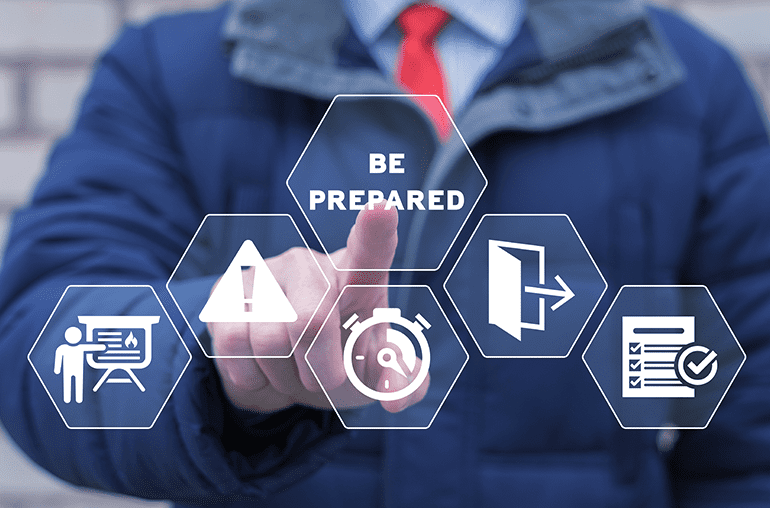
Our collective experience of going through the COVID-19 pandemic and the pace and magnitude at which we’re experiencing or hearing about natural disasters have caused many to become more vigilant about disaster preparedness. Many are asking themselves, What is my disaster plan for my family, myself, my community, my company?
A key component of a disaster preparedness plan is maintaining network connectivity and the ability to communicate. This is crucial for anyone trying to get through a crisis, and for businesses, it means the difference between continuity and chaos. The network is like a lifeline. In this blog post, we’ll explore the importance of being ready for the worst while leveraging the latest advancements in communications technology to ensure you stay connected when it matters most.
Start with Your Core Network
When it comes to disaster preparedness for organizations, Software-Defined Wide Area Networking (SD-WAN) is a good place to start. SD-WAN technology enables the intelligent management of multiple network connections, including broadband, 4G/5G, and MPLS. In addition to offering more bandwidth and integrated security, SD-WANs provide ubiquitous coverage, continuous application performance monitoring, and intelligent automation, which are important capabilities to have during a crisis.
If there is a network failure, SD-WAN intelligently and automatically reroutes traffic through the most stable and available access point, leveraging multiple types of connections, such as broadband, MPLS, 4G/5G, or satellite. Traditional WANs, on the other hand, often rely on a single, dedicated connection – a single point of failure – which can be vulnerable to outages caused by factors like natural disasters, equipment failures, or cyberattacks. The redundancy built into SD-WAN architecture enhances network resilience, reduces downtime, and ensures uninterrupted communication during crises. In fact, we have a customer that weathered Hurricane Ian, and their SD-WAN network never went down. This allowed their various locations to maintain connectivity with one another and allowed them to continue delivering products and services to customers, which were essential through the disaster and its aftermath.
Wireless Backup for Network Outages
4G LTE backup can act as the failsafe and the alternate route for data traffic in the event of a primary network outage or disruption. Many organizations already use 4G LTE infrastructure for their mobile communications, so it can be practical, efficient, and low-cost to leverage it for backup connectivity. SD-WAN automatically detects failure and seamlessly switches to the wireless network. 4G LTE is activated quickly, minimizing downtime and keeping essential applications and services accessible.
4G LTE and 5G operate independently of wired networks, making it less susceptible to outages or failures that may affect those networks. Even during crisis situations like severe weather events which could cause significant network infrastructure damage, LTE and 5G networks can often remain operational, offering a stable route for data traffic. Wireless backup in combination with SD-WAN is a reliable networking infrastructure that allows critical applications and services to remain accessible to users, during crises, disasters, and primary network outages.
Back-up Kit for Phone Calls
In a crisis, sometimes you just need to call out. To address this concern, MetTel developed a solution, MEDIK – Mobile Emergency Data & Internet Kit – which provides portable phone service. MetTel’s MEDIK has the ability to make phone calls via battery, outlet, or WiFi, and even without power can provide a dial tone for days. As a replacement for down phone lines or as backup, MEDIK receives LTE connectivity as temporary work sites. Get dial tone when you need it, wherever you are. The device supports SIM cards from all major carriers and with connection to 4G LTE cellular service, downtime is at the lowest possible level. The kit can also be provisioned for security alarms and can serve as a Wi-Fi access point. MetTel’s MEDIK is suitcase-sized and easy to use – simply plug it in, extend the antenna, and power it on.
Single SIM
Another important piece of technology that would be beneficial to have in a disaster is the Single SIM for mobile devices — smartphones, tablets and laptops. MetTel’s Single SIM roams intelligently across the world’s largest communications network to find the strongest mobile signal in any location – regardless of carrier – facilitating seamless connectivity worldwide. MetTel’s Single SIM is good to have in general, and in a disaster, will provide access to whichever networks are still up and running.
Wireless WAN
When wired connections aren’t available, MetTel works with Digi and Cradlepoint to provide cloud-controlled LTE and 5G edge solutions to stay connected and productive. Wireless WAN connects thousands of endpoints and grants users access to the cloud, data center applications, and the internet, securely and in near real-time.
Cloud-Based Tools
VoIP, Hosted PBX, Unified Communications, Contact Center as a Service, and Direct Routing or Operator Connect for Microsoft Teams are all examples of cloud-based communication solutions that are not tied to a physical location. If physical offices become inaccessible, these tools can allow employees to still connect and collaborate from anywhere with internet connectivity. The cloud can also be leveraged for secure storage and data redundancy, allowing critical information to be accessible and safeguarded.
Training, Testing, and Updating
As you train your employees on safety and emergency procedures that will protect their physical well-being, incorporate communications protocols for additional safety measures, as well as business continuity. Distribute emergency contact lists, establish clear lines of communication, and share contingency plans to ensure everyone knows their role should disaster strike. And in the same way that you would run a fire drill in a building, it is a good idea to run a crisis or disaster simulation. This will help ensure that everyone knows what to do and how to do it. In addition, running drills will allow you to test the technology that you have in place, and it could help with testing new technologies that you may want to incorporate.
Always Be Prepared
Embracing technologies like SD-WAN, Wireless backup and Wireless WAN, Single SIM, and cloud-based communication, can strengthen your organization’s ability to remain connected and operational during a crisis. This reliable technology combined with regular employee training will result in a robust disaster preparedness strategy that will help you achieve the agility and resilience necessary to function and thrive in an unpredictable world.
If you have any questions about Managed SD-WAN, MEDIK, or disaster preparedness for your network, please contact us.


